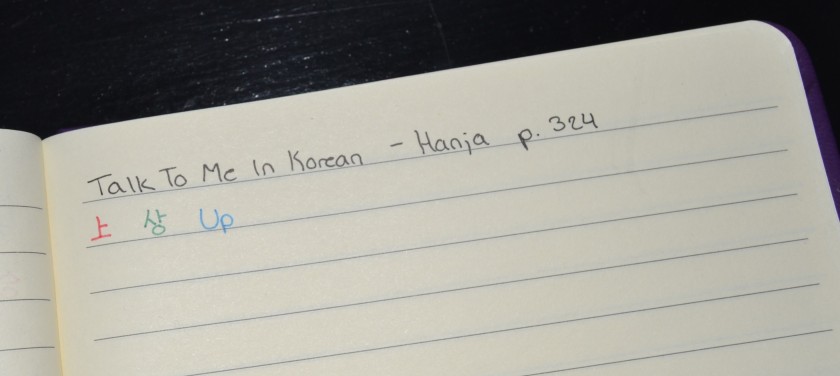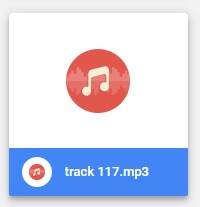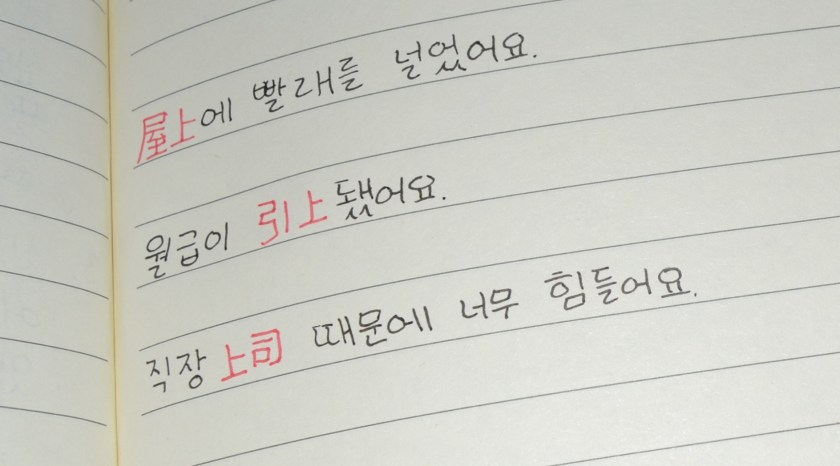Good evening guys!
Yesterday I finished the ‘Your First Hanja Guide’ book by Talk To Me In Korean and I wanted to share with you all how I’ve been studying with the book every day, for the past few months.
Before I begin I would like to mention that I really enjoyed working with the book and I definitely recommend it if you want to try studying Korean through hanja. If you are curious about the book then I recommend that you read this review by the brilliant Sofie, watch this video by TTMIK themselves or you can read more about it on the mykoreanstore website where you can also buy the book.
Alright, let’s begin!
As always, I begin by preparing the things I need.
I usually have the book I’m studying with, my notebook, pens, correction tape and 원고지 paper. 
I always begin by jotting down what book I’m working with, along with the page, subject or whatever else I find interesting.

I then open up my 원고지 notes and practice writing the character. The thing is, if you are only going through these hanja characters in order to improve your Korean skills, then you don’t need to practice writing them at all. As long as you know that they exist and what they mean, then you really don’t need anything else.
However, I have known for almost two years now, that I want to learn Chinese in the future, so I’m basically using this as an opportunity to get more comfortable with the different characters and their strokes, so in my case it simply makes sense to put a little more effort into my notes. I also found it oddly calming to repeat all the strokes over and over again. It reminds me of the reasons why I bought some calligraphy books in Korea. Maybe I’ll pick them up soon and give it a try..

I then go on listen to the accompanying audio files twice. The first time I simply listen carefully to the pronunciation and intonation, and the second time I read aloud while listening. Lastly, I then read the words and sentences aloud once again, without listening to the file, while trying to sound as natural as possible.

I then move on the jot down some notes about the hanja character. I write down whatever I find interesting or relevant in order for me to better remember it the next time I see it, or to help make it easier for me to tell it apart from other characters.
It can be a breakdown of the characters that help create the new character or it can be some notes on how the character got it’s meaning.

Once I feel like I have written down anything of interest, I move on to write down the list of Korean words that are based on that hanja character. As always, I color code my notes. In this case, hanjas are always written in red, to make easier for me to spot them in my notes. After writing down all the hanjas, I take out my green pen and write down the words in hangul next to the hanja. That way I can actually read the words that I’m working with.
Lastly, I take my blue pen and write down the definition of the words that I didn’t know already.

As the last part I write down the sample sentences. I do this in order to get more familiar with both the hanja word, the sentence structure and spelling of the different words. It can be really helpful to copy down some notes like these. I also avoid writing the hangul version of the words in the sample sentences. I do this because I want to encourage my brain to start remembering them without the hangul. It usually isn’t a problem since the rest of the sentence kinda gives the meaning away, and if not then I can simply find the hanja in my notes right above the sample sentences.

And that’s basically it! It’s pretty simple but I get to read, listen, write and speak as well, so I found it quite helpful.
As for time, this specific character was pretty simple and didn’t take a lot of time, but some characters are a lot more tricky and has a lot more related words, so it’s going to change a lot depending on the characters your working with.
I hope you all found some inspiration to study with this (or another) book.




















 After reading the dialog and following up on the vocabulary, the real fun begins. A grammar pattern from the dialog is introduced and followed by a few sample sentences that allows you to become more comfortable with that specific pattern.
After reading the dialog and following up on the vocabulary, the real fun begins. A grammar pattern from the dialog is introduced and followed by a few sample sentences that allows you to become more comfortable with that specific pattern.
